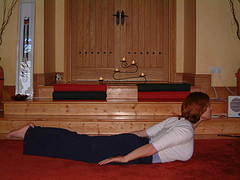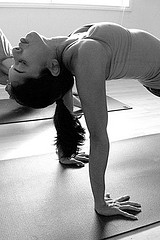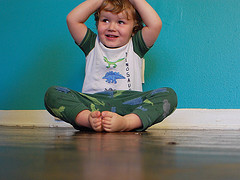Yoga Asana
Displaying 1 - 35 of 35 » page 1 of 1
Journal Post
We just passed through the first New Moon of the New Year. New Moons are always potent times to set intentions, but particularly the first New Moon of the New Year. This past year felt particularly destabilizing and I have absolutely cherished my yoga practice, as it keeps me steady, clear and grounded in the present. I pay fairly close attention to what is going on around me, but as a yoga practitioner, one of the disciplines of the practice is to not get pulled into the drama - the ups and downs of everyday human existence.
One of my first experiences with yoga was a kundalini yoga class at a YMCA in Oregon. My friends and I would attend every week. Although, I had no idea why the woman leading the class wore a turban on her head, it was the highlight of my week. One of the poses we practiced was Urdhva Prasarita Padasana. As we lay down on our backs, our arms remained along the sides of our body while our feet extended up to the ceiling. Instead of stretching the palms, we created fists with our hands and beat the ground with our fists for about 60 seconds. Afterwards, we bent our knees and rested on our backs for a few moments before moving on to the next pose.
Today marks the halfway point between the summer solstice and the fall equinox. It's called Lamas and it signals the beginning of the harvest season. We are about to transition into Late Summer as we move beyond the peak of summer. Before we do, take with you the lessons learned from your growth this year. Take some time to honor what you have accomplished before you begin to reap what you have sewn.
When a baby enters your life it’s like a deep void being filled up, one that you never realized was there! The little bundle of joy sure makes everything alright—the overwhelming nine months of pregnancy, the excruciating experience of going into labor, and quiet not-your-favorite kind of changes happening with your body.
However, let's not lose sight of all the hormonal and visibly physical changes happening with your body in the post-partum and the need for a sustainable mechanism to psychologically relax and set your systems back to health. What better than yoga?
Yoga is the science of unity. It unites each and every particle of the universe to create an intelligent world. Yoga has the ability to regulate every action within the body. Those who practice the ancient science routinely feel the magic of asanas on the body. The biggest impact of Yoga is undoubtedly on the human brain from where all the body processes are administered. The teachings of positivity, self-love, and great inner strength that the holistic art imparts helps a man create a habit of sustainable living. From the physical form of Yoga to the mental form, the India-born science guides a person to achieve their goals in all possible ways.
I taught a restorative yoga retreat last month where we contemplated the energy of the Ayurvedic constitution made up of Earth and Water, Kapha. We contemplated stability, density, structure, boundaries and flow. We discussed ways to antidote the excess and deficiencies that arise with these elements, which are predominant in the winter and early spring.
One of my favorite topics to discuss as a remedy for Winter stagnation is the creation of clear un-obstructed space. This time of year is ideal for space clearing of any kind. As a Virgo and a Pitta Kapha, this brings me joy.
It has been a little while since you have received an email from us. If we are being totally honest, this past year was a particularly challenging one on a number of different levels, personal and professional. I remember reading and sharing about last year being the Year of the Fire Rooster, in Chinese Astrology. What I read, indicated that Rooster years are about doing the constant disciplined day to day work. I certainly found this to be true this last year. It was a year of keeping my nose to the ground, putting one foot in front of the other and doing the work. Have any of you found this to be true?
Happy Lunar Fire Monkey New Year! As I have mentioned before, I always feel much more ready for the New Year in tune with the Lunar cycles of the year. And for it to be a Yang Fire Monkey Year, what could be better for iHanuman? It sounds like this is going to be a fire cracker of a year, so get ready! But as we mentioned last month, we are still in the slower, darker, yin winter season, so it's ok to continue to ease your way into your new year.
Who was Vanda Scaravelli, you ask? My initial response is usually, "Brilliant." We all know the basics: she was a pianist, close friends with Jiddu Krishnamurti, and she started Yoga late in life. She studied with the great masters, B.K.S. Iyengar and Desicachar, and she is the author of the lovely book, "Awakening the Spine.
In Yoga, shoulder stand is known as the queen of all asanas while headstand is the king of all asanas. Thus, subtly suggesting that headstand is superior to shoulder stand
But we all know that behind every powerful king there is an even more powerful queen…J
The question remains: is headstand stand actually ‘better’ or more powerful than shoulder stand?
We are so grateful for your support!
iHanuman is going through many changes as we work to bring our updated media platform online. We look forward to unveiling our new site and all of the great content you have been waiting for. We just wanted to take a moment to say thank you to all of you who have supported us over the years. We are a small company with BIG ideas and we look forward to sharing some big news withyou over the coming weeks. We have also had many requests for more classes from John Schumacher. His latest classes will be available next month, so stay tuned for an update.
I'm just back from my third annual Yoga workshop in Hailey, Idaho. When I asked the folks up in Hailey what they wanted to work on this year they set me an interesting task: a weekend workshop based on poses named after Hindu gods. After digging through Iyengar's Light on Yoga (200 asanas), Yogeshvara Paramahamsa's First Steps to Higher Yoga (300 asanas), and the Lonavla Institute's Encyclopedia of Traditional Asanas (900 asanas), I decided to open things up and include in the workshop poses named after Hindu sages and one famous monster. And so we had a Virabhadra Class (the hideous demon created by Shiva to punish his father-in-law), a Sages Class, an Avatars of Vishnu Class, and a Shiva Nataraja Class.
I have no shame admitting that I tend to get a little carried away every now and then. Let's be honest, I wouldn't be the Capricious Yogi if I didn't! In fact, with all the recent transition and activity swirling around me, it's a wonder that I'm not floating amongst the clouds for eternity. I've been up and down and all around. Without yoga and a grounding practice, I can only imagine how much more off kilter I'd be. Grounding. It's that feeling of stepping on my mat, finding my seat, connecting all four corners of my feet that ultimately rejuvenates me. It's the moments when I can take off my shoes and walk barefoot or feel the warm sand between my toes.
Paying attention to alignment in your yoga postures can be confusing. Lift this, drop that; lengthen here, shorten there; soften one side and strengthen the other one. And, in the meantime: don't forget to breathe.
For many students, looking more closely at alignment can be intimidating. Alleviate that stress by breaking the postures up into sets with alignment points in common. For example, in standing postures, we can say that we are either focusing on squaring the hips or on opening them. Although this is somewhat of an oversimplification, it can help students that are newer to alignment principles get a handle on where to start.
If you need some inspiration to reinvigorate your daily yoga practice, September is a great month to start.
A couple of weekends ago, I attended a workshop with the illustrious Bobby Clennell. Bobby wrote AND illustrated The Woman's Yoga Book: Asana and Pranayama for All Phases of the Menstrual Cycle .
.
People who have never practiced yoga before often ask me to teach them a yoga pose. The Iyengar student in me cannot help but start by teaching Tadasana. People are often astounded by how much integrity and poise there is when conscious attention is brought to the simple act standing. They are amazed at how much attention can be brought to the four corners of the feet, the inner line of the legs, the lift of the knee caps and the release of the tailbone. Once we build the foundation. we move to the upper body and take a deep inhale to engage the abdomen, lift the sternum and lift and roll the shoulders back.
Supta Virasana, or Reclining Hero's Pose, is practiced by first situating yourself into Virasana, Hero's Pose. This pose can be very difficult on the knees, so take it easy. If you are unable to sit completely between your heels, as in the picture to the left, then sit on a yoga block or a blanket. You want to be sure that there is NO pain in the inner or outer knees. Take a few breaths here to settle into the pose and add props as needed.
We are surprised to find, or not find rather, Vrschikasana, Scorpion Pose, listed among the backbends or the arm balances on the Yoga Journal List of Poses. As we wind down our backbends as we approach the spring equinox, we would be remiss in not including this challenging backbend among our poses.
There is no one pose that is the most feminine pose. Some poses are more feminine than others and some poses make you feel more feminine on different days of your practice. Ardha Chandrasana, Half Moon Pose, always feels very feminine to me. Perhaps it is because when I practice it on a good day, I feel extremely graceful and elegant. And while the name, camel pose, may not sound very feminine, Ustrasana, is very uplifting and powerful.
For any yogi who has a favorite friend of the canine variety, you cannot help but smile when they practice upward or downward dog. Urdhva Mukha Svanasana, or upward facing dog, is another in our series of backward bending poses which is also clearly an arm and wrist strengthening pose. Poses such as Bhujangasana, Cobra Pose or Setu Bandha Sarvangasana, Bridge Pose, are excellent preparatory poses for Upward Facing Dog pose.
Bhekasana or Frog Pose is another challenging backbend which requires strength not only in the back but also in the arms and flexibility in the shoulders. Bhekasana is best practiced after warming up with standing poses or other preparatory backbends.
Sometimes we get carried away with backbends. They tend to be fun and energetic poses, but we also need to remember that it is still wintertime and we are slowly coming out of our caves of hibernation and what we often need is a restorative yoga practice. Most of us need this form of yoga practice much more often than we like to admit. We can become wrapped up in the physicality of yoga poses and how yoga can make us stronger and more flexible and more virile. But yoga also restores us to balance and helps us relax and truly rest our western overactive minds and bodies.
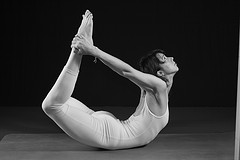 Dhanurasana, or Bow Pose, is a fantastic back-bending pose for opening the chest and shoulders and strengthening the back. This pose is challenging as it reminds how important the legs are in back-bending poses. In addition to the strength in the back required for backbends, there is even more strength required in the legs, particularly the quadriceps.
Dhanurasana, or Bow Pose, is a fantastic back-bending pose for opening the chest and shoulders and strengthening the back. This pose is challenging as it reminds how important the legs are in back-bending poses. In addition to the strength in the back required for backbends, there is even more strength required in the legs, particularly the quadriceps.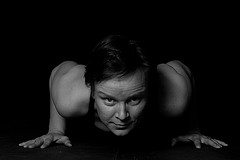 Chaturanga Dandasana or the Four-Limbed Staff Pose is also called Plank Position. Chaturanga Dandasana is itself not described as a backbend but is often used to prepare for backbends because it strengthens the spinal muscles. Plank pose is the infamous Yoga Push Up which is one of the sequence of asanas in Surya Namaskar or Sun Salutations.
Chaturanga Dandasana or the Four-Limbed Staff Pose is also called Plank Position. Chaturanga Dandasana is itself not described as a backbend but is often used to prepare for backbends because it strengthens the spinal muscles. Plank pose is the infamous Yoga Push Up which is one of the sequence of asanas in Surya Namaskar or Sun Salutations.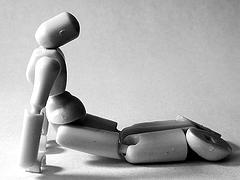 Open the heart and stretch the belly with Bhujangasana or Cobra Pose. Back bends stimulate the Kidney Energy and invigorate the heart. Back bends can counteract the effects of depression. During the winter, many people experience Seasonal Affective Disorder, SAD, because of the decrease in light. Back bends, when practiced correctly, elevate our mood. This gentle back bend improves digestion and creates flexibility in the spine.
Open the heart and stretch the belly with Bhujangasana or Cobra Pose. Back bends stimulate the Kidney Energy and invigorate the heart. Back bends can counteract the effects of depression. During the winter, many people experience Seasonal Affective Disorder, SAD, because of the decrease in light. Back bends, when practiced correctly, elevate our mood. This gentle back bend improves digestion and creates flexibility in the spine.It is wintertime. One of the best seasons to practice yoga simply because it is an excellent indoor activity. In the chinese tradition, wintertime is a time to focus on balancing the Kidney Energy (Qi). One way to access the Kidney Qi is to practice backbends. And since it is February, it is also nice to focus on poses that open the heart. One of the myriad backbending asanas to choose from is Matsyasana or Lord of the Fishes pose. Yoga Journal has a good description for practicing Matsyasana. Unfortunately, I was unable to find a good video description of this pose, so we will just have to create one...
Fine tune your approach to Corpse Pose through an exploration of varying teaching philosophies.
By Sara Avant Stover
By Sara Avant Stover
I've been intending for a couple of months to pick up our story line with Sri Yogendra, one of the unsung heroes of modern yoga. Born Mani Desai in 1897, he became in his late teens a disciple of Paramahamsa Madhavadasa, who at the time was reputed to be 118 years old. Paramahamsa, which means "great swan" (or "goose") is an honorific title given to highly enlightened beings (why is an enlightened person compared to a swan? That's a long story for another time). Mani's father threw a fit when he found out his son-a bright kid destined for great things in the world-had dropped out of college to become a yogi, which in those days meant a life of renunciation and celibacy.
If you're like most people nowadays, you probably spend a good portion of your waking hours sitting, mainly at your desk at work, but also driving in your car, at home reading or watching TV. But in fact humans aren't well adapted to spend long hours every day sitting in a chair. Our bodies crave and thrive on movement. Sitting, especially for prolonged periods of time, is actually more stressful on our spine, and the little spongy disks between the bony vertebrae, than standing. This stress is compounded by two other problems: most modern chairs are poorly designed for healthy sitting, and most people have poor posture (and not only while sitting but standing as well).
Are you a Yoga Teacher?
Are you a Yoga Student?
Do you Own a Yoga Studio?

